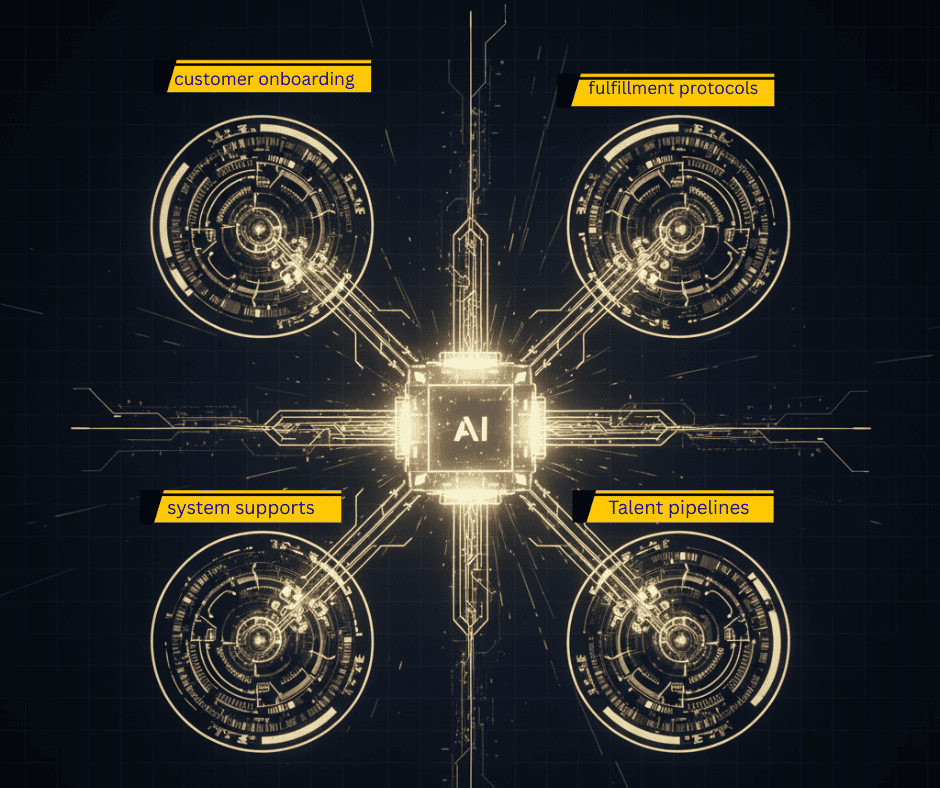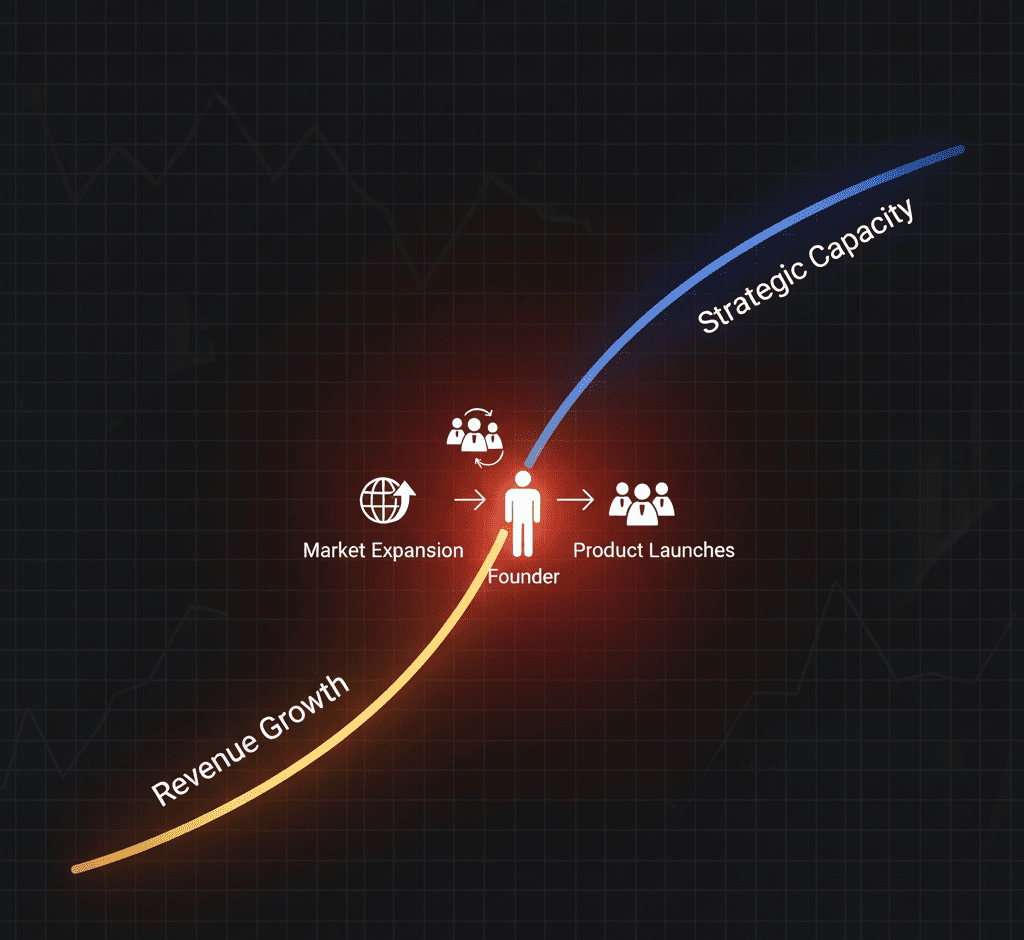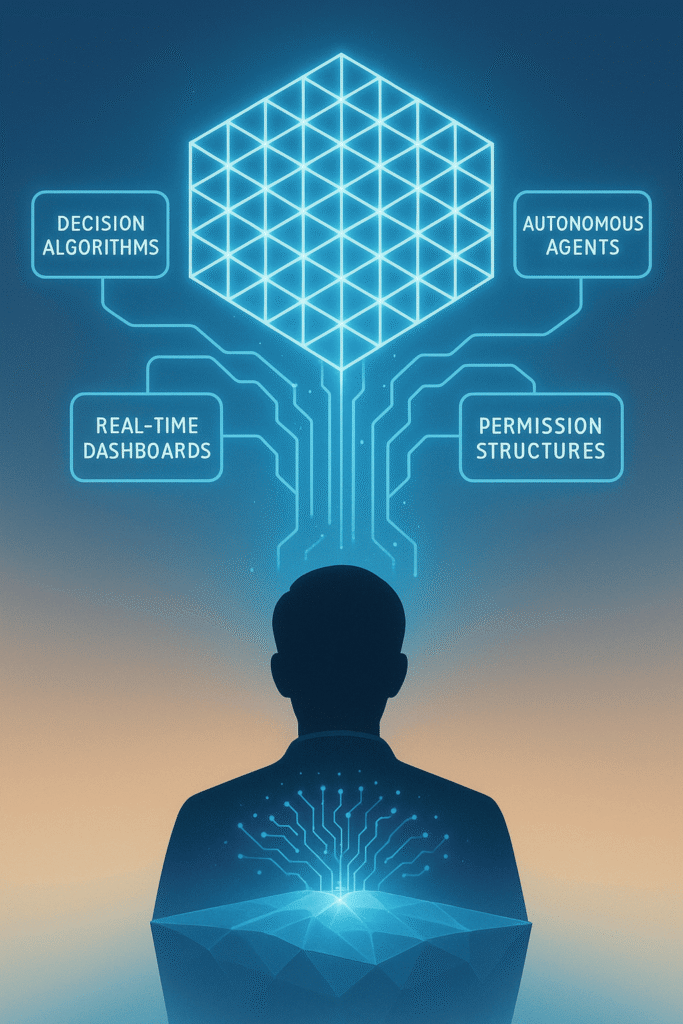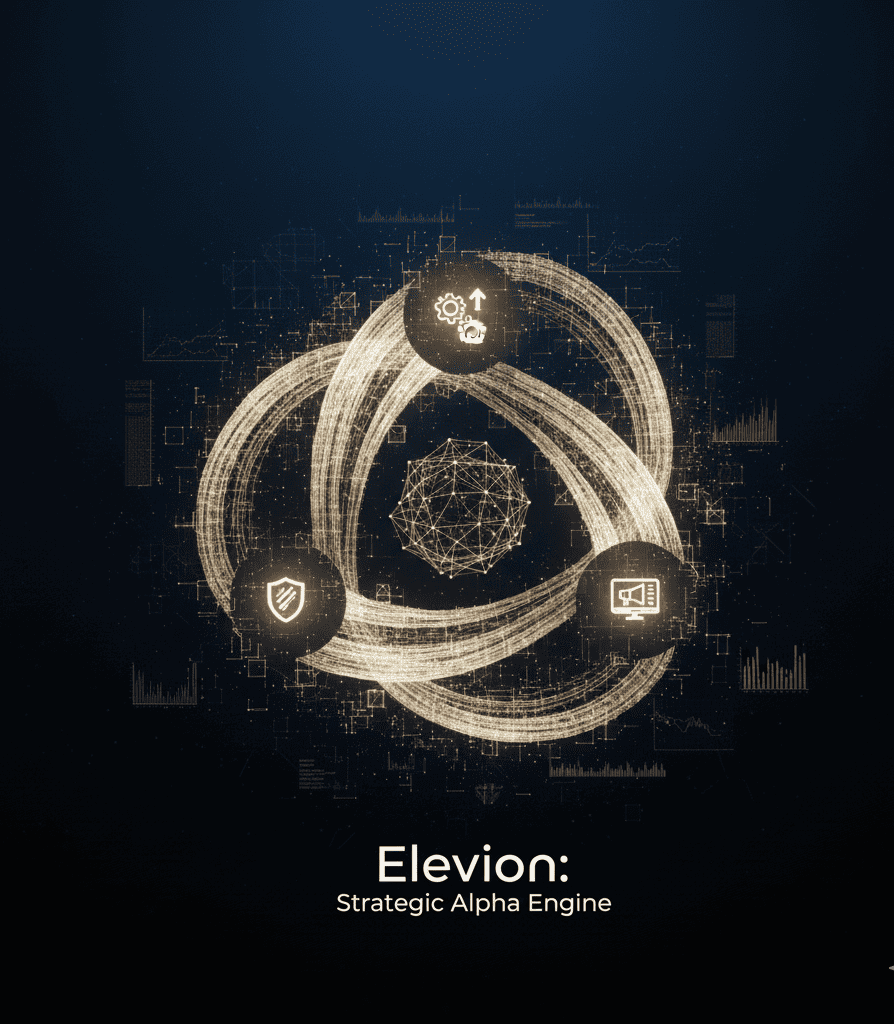
The Strategic Alpha Engine: Operational Alpha
The Definitive Diagnosis: The Operational Bottleneck Trap
Traditional operations consulting suffers from a catastrophic misdiagnosis: it treats operational efficiency as an optimization problem rather than a strategic architecture challenge. Legacy firms deploy process mapping exercises, lean methodologies, and workflow automation tools that create the illusion of systematic improvement while leaving the fundamental bottleneck intact—the founder’s irreplaceable cognitive involvement in activities that should be algorithmically controlled. This is process theater: the optimization of visible inefficiencies while the structural constraint that limits scale remains unaddressed and often unidentified.



The resulting pathology is Strategic Decay—the progressive degradation of competitive advantage as organizational complexity outpaces the founder’s cognitive bandwidth. In the early stages, founder involvement in operational decisions creates velocity and quality through direct oversight. But as the business scales, this same involvement becomes an exponential drag: every new market, product line, customer segment, or team member adds decision-making load that concentrates at the founder bottleneck. The organization develops structural helplessness, waiting for founder input on questions that should be encoded in systems, playbooks, or autonomous agents. High-agency talent atrophies or exits. Strategic opportunities remain unexploited because founder attention is consumed by operational firefighting. The business achieves revenue growth while simultaneously experiencing capability decline—a deceptive trajectory that masks existential vulnerability until a market shock or competitive displacement reveals the fragility.
The fundamental error is a failure to distinguish between activities that require the Founder’s Cognitive Signature—those rare decisions where the founder’s unique pattern recognition, risk tolerance, and strategic vision create irreplaceable value—and those that should be systematized, delegated, or eliminated entirely. Traditional operations consulting cannot make this distinction because it lacks the causal intelligence to identify which processes actually drive competitive outcomes versus those that merely consume resources. The result is the systematization of low-leverage activities while high-leverage bottlenecks remain embedded in founder workflow, creating the worst possible outcome: increased operational complexity with no improvement in strategic capacity.
Operational Alpha represents the categorical solution to this structural deficiency. Rather than optimizing processes in isolation, we deploy causal audits to identify which operational activities possess genuine strategic efficacy and where founder involvement creates value versus catastrophic single-point-of-failure risk. The output is Systemic Process Hardening—the transformation of operational architecture from founder-dependent to algorithmically controlled, enabling the organization to scale without diluting quality, velocity, or competitive differentiation. This is not incremental efficiency improvement; it is the engineering of Compounding Efficiency Gains where each systematized process increases organizational capacity to absorb additional complexity without proportional increases in founder cognitive load.

The Elevion Methodology: Operational Alpha as a Systemic Advantage
Our Operational Alpha capability operates as a forensic diagnostic and architectural redesign system that transforms operations from a source of strategic drag into a compounding competitive weapon. This methodology eliminates founder bottlenecks while preserving the cognitive signature that drives genuine competitive advantage:
Inputs: Causal Audits of Founder Bandwidth and Systemic Friction:
- Granular time-motion analysis of founder activity allocation, identifying which tasks consume cognitive bandwidth versus which leverage unique founder capabilities that create disproportionate strategic value
- Causal mapping of operational dependencies to reveal hidden bottlenecks where process handoffs, approval chains, or information asymmetries create exponential friction as the organization scales
- Systematic identification of activities currently requiring founder involvement that possess zero causal relationship to competitive outcomes—these represent pure waste that can be eliminated or delegated without performance degradation
- Analysis of organizational learned helplessness patterns where team members escalate decisions unnecessarily due to absence of clear decision protocols, creating artificial founder dependency that compounds with headcount growth
- Detection of operational debt—accumulated workarounds, manual processes, and tribal knowledge dependencies that function adequately at current scale but will catastrophically fail under growth stress
Process: Systemic Process Hardening and Algorithmic Delegation:
- Construction of decision algorithms and playbooks that encode founder judgment into replicable protocols, enabling high-quality decision-making without founder involvement while preserving strategic intent and quality standards
- Deployment of autonomous agents and intelligent automation that handle routine operational tasks with higher consistency and lower error rates than human execution, freeing cognitive bandwidth for genuinely strategic activities
- Creation of organizational permission structures that specify decision-making authority at each organizational level, eliminating unnecessary escalation while maintaining appropriate oversight on decisions with strategic consequence
- Implementation of real-time operational dashboards that provide diagnostic visibility into process performance, enabling proactive intervention before operational failures compound into strategic crises
- Design of scalable organizational architecture where complexity absorption capacity increases faster than complexity introduction—each new market, product, or team member requires proportionally less founder attention than the previous one


Output: Compounding Efficiency Gains and Scalable Organizational Architecture
- Measurable reduction in founder cognitive load allocated to operational oversight, with quantified reallocation of bandwidth toward high-leverage strategic activities (market positioning, capital architecture, ecosystem development)
- Operational systems that improve with scale rather than degrading—data accumulation enhances algorithmic performance, process refinement becomes embedded in continuous improvement loops, and organizational learning compounds rather than fragments
- Elimination of single-point-of-failure dependencies where business continuity depends on specific individuals’ availability or tacit knowledge, creating organizational resilience that survives talent transitions without capability loss
- Compounding Efficiency Gains where each systematized process creates capacity to systematize additional processes, generating exponential rather than linear improvement in organizational capability per unit of invested effort
- Scalable organizational architecture capable of absorbing 10x growth in revenue, customers, or geographic markets without proportional increases in operational complexity, overhead costs, or quality degradation
The System Linkage (The Integration Moat)
Operational Alpha functions as the execution engine that transforms strategic intent into market reality—without this capability, even the most sophisticated strategy devolves into unrealized potential. The integration with Elevion’s broader System of Strategic Alpha is structural, not optional: operational excellence divorced from strategic alignment creates efficient execution of the wrong activities, while strategy without operational capacity generates unrealized plans that competitors exploit.
Operational Alpha must be informed by AI-Driven Strategy to ensure the right processes are optimized. Traditional operations consulting optimizes for local efficiency—making existing processes faster or cheaper—without validating whether those processes possess causal efficacy in driving strategic outcomes. Our causal inference models identify which operational activities actually create competitive advantage, customer lifetime value, or strategic optionality versus those that merely correlate with business activity. This diagnostic input prevents the catastrophic error of systematizing low-leverage processes while high-impact bottlenecks remain unaddressed. The result is operational architecture causally aligned with strategic objectives: every systematized process directly contributes to competitive differentiation, margin expansion, or market positioning rather than merely reducing visible inefficiency.

The capability enables the velocity required for Market Entry success. Asymmetric growth opportunities exist in temporal windows—the period between predictive identification of an emerging market and mainstream competitive recognition. Exploiting these windows demands operational architecture capable of rapid scaling without quality degradation or capability dilution. Our Operational Alpha methodology constructs the systematized infrastructure—customer onboarding protocols, fulfillment systems, support playbooks, talent acquisition pipelines—required to capture market share at the velocity the opportunity demands. Without this operational readiness, even perfect market timing fails: competitors with superior execution infrastructure neutralize first-mover advantage through faster, more reliable delivery despite later market entry. Operational Alpha synchronizes execution capacity with strategic opportunity, eliminating the lag that converts temporal advantage into missed opportunity.
Operational Alpha is the structural carrier that delivers the brand promise established by Brand Fortification. A compelling brand narrative creates market expectation; operational systems determine whether that expectation is fulfilled or violated. Brand value compounds when customer experience consistently exceeds the promise—this consistency requires operational architecture that hard-codes brand values into every customer interaction through systematized processes, quality controls, and service protocols. Our Operational Alpha capability transforms brand positioning from marketing aspiration into operational reality by engineering the fulfillment infrastructure that creates differentiated customer experiences at scale. This is how brand moat transitions from narrative artifact to structural competitive advantage: the operational systems become so refined at delivering the brand promise that competitors cannot replicate the experience without equivalent operational sophistication, creating compounding defensibility through execution excellence.
The integration moat is architectural: Operational Alpha generates compounding competitive advantage only when strategic alignment, market velocity, and brand delivery operate as a unified system. Isolated process optimization—even technically excellent—fails to create strategic value if it improves the wrong activities, cannot scale at market opportunity velocity, or delivers experiences misaligned with brand positioning.
Engage the System
The most dangerous founder delusion is operational indispensability—the belief that business quality depends on their continued involvement in operational decisions. This psychological pattern is structurally catastrophic: it creates artificial ceilings on organizational scale, converts founder cognitive bandwidth into a depleting rather than renewable resource, and builds existential single-point-of-failure risk into the business architecture. The irony is that founders cling to operational control precisely because they lack the systematic infrastructure that would enable confident delegation—they remain operationally embedded because they have never engineered the algorithmic systems that would render their involvement unnecessary.

Strategic freedom does not result from working harder or delegating more—it requires systematic reconstruction of operational architecture to eliminate founder dependency while preserving competitive quality. Every quarter you remain the operational bottleneck is a quarter your competitors potentially gain scale advantages through superior organizational architecture. Every decision that requires your approval is a decision that cannot be made when you are unavailable, creating velocity constraints that compound into strategic disadvantage. The founders achieving exponential growth without proportional increases in cognitive load are not those with superhuman work capacity—they are those who engineer operational systems that create Compounding Efficiency Gains rather than linear operational scaling.
Operational Alpha is not process improvement—it is the transformation of operations from strategic liability into competitive weapon. It is the systematic identification of your unique cognitive signature and the ruthless engineering of systems that preserve that signature while eliminating your involvement in activities where human judgment creates bottlenecks rather than value. The question is not whether you will scale your operations—it is whether you will scale through founder exhaustion and organizational fragility, or through systematized architecture that compounds efficiency faster than complexity grows. Traditional operations consulting cannot answer this question because it optimizes processes without validating strategic causality, creating the illusion of improvement while the fundamental constraint remains unaddressed.